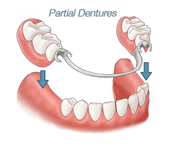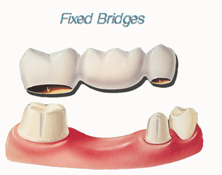Dentures are removable dental appliances that are used to replace missing teeth. There are two types of dentures – complete and partial. Complete dentures are required when all the upper and/or bottom teeth are missing.

Complete dentures may be immediate or conventional. Immediate dentures are used at the time the teeth are removed to keep you from going without teeth during the time it takes for all the tissue to heal, usually 4 to 6 weeks. After the gum tissue heals a conventional denture is placed. A partial denture fills in the space left by missing teeth and also prevents neighboring teeth from shifting.
Dentures are durable appliances and will last many years, but may have to be remade, repaired or readjusted due to normal wear or changes in gum tissue caused by aging. Dentures not only improve speech and chewing, they may actually improve your smile.
Dentures require multiple appointments over a period of several weeks. The process starts with high accuracy molds (impressions) or digital scans which are used to fabricate your custom denture. Several “try-in” visits may be necessary to make adjustments to achieve the proper fit, shape and color. On the final visit, your dentist will make a final adjustment to achieve a comfortable, natural fit and place the completed denture. It is normal to experience increased saliva flow, speech and chewing difficulty and some soreness, but this will subside as your muscles and tissue become familiar with the new denture.
Root canals are employed in order to save a tooth whose nerve has experienced decay or infection. The pulp (living tissue inside the tooth) is removed, along with nerves, bacteria and any decay and the space is filled with special medication and dental materials, which will restore the tooth to full functionality. The absence of nerves will allow your dentist to prepare that tooth with any anesthesia.
For many reasons, root canal therapy is preferable to extracting (pulling) the tooth. Extracting a tooth is more costly in the end and can lead to major problems for neighboring teeth. Root canal therapy is highly successful and lasts a lifetime, although new infections might require further treatment. Root canal therapy is indicated whenever decay has reached the pulp (living tissue inside the tooth), when infection or an abscess (pimple) has developed inside the tooth or at the root tip and when there is severe injury to the tooth caused by trauma.
Root canal therapy may be required if there is an abscess (or pimple) on the gums, when there is sensitivity to hot and cold, severe tooth pain, swelling and/or tenderness. Occasionally root canal therapy is indicated in spite of there being no symptoms at all.
A root canal procedure requires one or more visits and should be performed by an endodontist (root canal specialist). While the tooth is numb an opening is made at the top of the tooth (biting surface) and a series of root canal files are used, one at a time, to remove the pulp, nerve tissue and bacteria. Decay is also removed with special dental instrumentation. Depending on the number of roots (front teeth have a single root, but a molar can have up to three roots) and the degree of infection it may be necessary to have additional visits. If a single visit is sufficient, the tooth is thoroughly cleaned and then sealed with a permanent filling. If additional appointments are required, a temporary filling will be used instead of a permanent one. On the last visit a permanent seal will be placed as well as a filling on the top of the tooth. All teeth that are root canaled require a crown (cap) which will protect the tooth and return it to full functionality. Some sensitivity after treatment is common but it subsides as the inflammation disappears and the tooth heals.
A dental bridge is a fixed, non-removable appliance used to replace one or more missing teeth. There are several types of bridges, but the most popular, by far, is porcelain (tooth colored). It is the most popular because it is the one that most resembles your natural teeth and allows you to smile with confidence in spite of having lost one or more teeth.
A bridge is made up of 2 crowns that go on the two anchoring teeth (abutments) on either side of the missing tooth or teeth. These crowns are attached to one or more artificial teeth (pontics) which fill the empty space left by one or more missing teeth.
Aside from filling the space left by missing teeth, bridges are used to prevent remaining teeth to drift from their normal position, to restore chewing and speaking functions, to upgrade from a partial denture to a fixed, permanent appliance and to maintain the overall shape of your face. Bridges are very durable and last for many years, but they may have to be replaced or re-cemented due to accidental damage or normal wear.
A bridge requires two or more visits. While the teeth are numb the two anchor teeth are shaped in order to receive a crown. Then a high accuracy mold (impression) or digital scans is made to send to a laboratory who will fabricate your permanent bridge. Another mold is made to allow your dentist to fabricate a temporary bridge, which will be cemented with temporary cement. The temporary checked to see that the chewing function is normal and the temporary bridge will be worn for several weeks until your next appointment. On your second appointment your permanent bridge will be placed and checked thoroughly and adjusted so that your bite is normal. Sometimes your dentist will cement your permanent bridge at this appointment, while on other occasions your dentist might prefer to use temporary cement to allow your gums and other teeth to feel comfortable with the new bridge and permanent cement will be used at a third appointment once this is achieved.
A composite (tooth colored) filling is used to repair a tooth with minimal or no visible evidence that the tooth has been repaired. Composite fillings can be used to repair cracks, decay, or other dental problems. The dentist removes the affected portion of the tooth and then places a composite filling.
Composite fillings and silver amalgam fillings are the most widely used today, although silver amalgam fillings are slowly disappearing because they are very visible, they contain mercury which can stain your teeth, they are not very stable and after a while the edges tend to break down. Composite fillings are definitely the choice for front teeth or any other visible tooth surface.
Composite fillings are usually placed in one appointment. After numbing the tooth, the dentist removes any decay and cleans and shapes the tooth to receive the filling. The composite filling is then precisely placed on the tooth and it is then shaped and polished, restoring the tooth to its natural shape, appearance and function. In case the decay is close to the nerve of the tooth, the dentist applies special medication after preparing the tooth and before placing the filling for protection.
A dental crown (or cap) is a cover that encloses all the surfaces of a tooth above the gum line, restoring that tooth to its original shape, function, feel and size. There are several types of crowns, but porcelain (tooth colored) crowns are the most popular because they resemble your natural teeth. Crowns are very durable and, with proper care, will last for many years, but they may eventually have to be replaced due to wear, compromised margin integrity and/or decay.
Dental Crowns are used to restore broken or fractured teeth, teeth that have decayed, teeth that have been root canaled and teeth that have large, fractured fillings.
A crown procedure requires two appointments, sometimes three. The first appointment includes preparing the surfaces of the tooth, removing and cleaning decayed portions, removing portions that have fractured and shaping the surfaces to properly and exactly for a precise fit with your permanent crown. Then highly accurate molds (impressions) are taken to create your custom crown. Another impression is used to create a temporary crown which will stay on your tooth for about 2 weeks or so using temporary cement, while the laboratory fabricates your permanent crown. Once the temporary crown is in place, your bite will be checked and adjusted, if needed, to allow you to bite properly. On the second appointment, your temporary crown is removed, your tooth will be cleaned and the permanent crown will be cemented (using permanent cement) after checking that your spacing and your bite are accurate.
Dental implants are a “root” device made of metal that is inserted into the jawbone to support restorations that resemble a tooth or group of teeth that replace a missing tooth or teeth. Most implants today are posts that are placed within the bone. The bone accepts the metal post and the bone tissue fuses with the metal (usually Titanium) post within a period of several weeks. Once the bone-metal integration is complete, the post can now anchor a number of restorations (prosthesis) such as crowns, bridges or dentures.